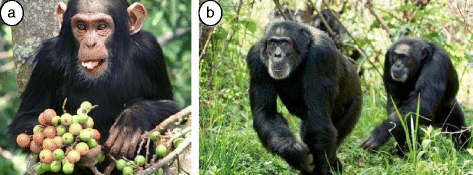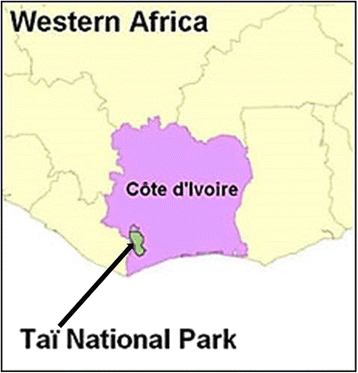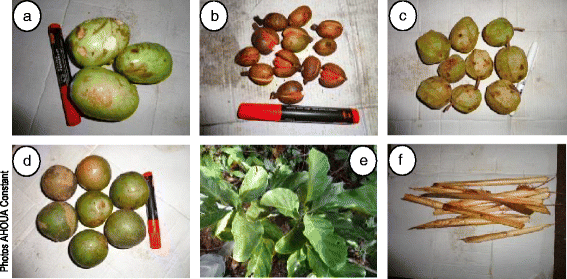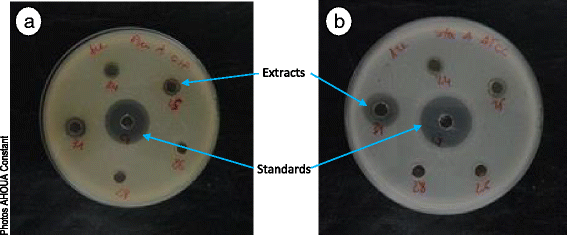Antimicrobial potential of 27 plants consumed by chimpanzees (Pan troglodytes verus Blumenbach) in Ivory Coast
- PMID: 26498034
- PMCID: PMC4618953
- DOI: 10.1186/s12906-015-0918-7
Antimicrobial potential of 27 plants consumed by chimpanzees (Pan troglodytes verus Blumenbach) in Ivory Coast
Abstract
Background: Due to their genetic proximity, chimpanzees share with human several diseases including bacterial, fungal and viral infections, such as candidiasis, acquired immune deficiency syndrome (AIDS), Ebola virus disease. However, in its natural environment, chimpanzees are tolerant to several pathogens including simian immunodeficiency virus (SIV), virus related to human immunodeficiency virus (HIV) that contribute to the emergence of opportunistic diseases such as microbial infections.
Methods: Twenty seven species of plants consumed by chimpanzees were evaluated for their antimicrobial potential against Escherichia coli, Pseudomonas aeruginosa, Staphylococcus aureus, Candida albicans, Candida tropicalis and Candida glabrata using the agar diffusion technique and micro-dilution in 96-well plates. In total 132 extracts (33 dichloromethane, 33 methanol, 33 ethyl acetate and 33 aqueous) were tested.
Results: The results showed that 24 extracts (18 %) showed activity against bacteria and 6 extracts (5 %) were active against yeasts. The minimal inhibitory concentrations (MICs) values of active extracts ranged between 23 and 750 μg/ml for bacteria and between 188 and 1500 μg/ml for yeasts.
Conclusion: Tristemma coronatum was the most promising on the studied microorganisms followed by Beilschmiedia mannii. The extracts of the two plants indicated by chimpanzees have potential for antimicrobial use in human.
Figures





Similar articles
-
Evaluation of the antimicrobial potential of medicinal plants from the Ivory Coast.Phytother Res. 2002 Aug;16(5):497-502. doi: 10.1002/ptr.970. Phytother Res. 2002. PMID: 12203276
-
Screening for antimicrobial activity of ten medicinal plants used in Colombian folkloric medicine: a possible alternative in the treatment of non-nosocomial infections.BMC Complement Altern Med. 2006 Feb 17;6:2. doi: 10.1186/1472-6882-6-2. BMC Complement Altern Med. 2006. PMID: 16483385 Free PMC article.
-
Investigations of antimicrobial activity of some Cameroonian medicinal plant extracts against bacteria and yeast with gastrointestinal relevance.J Ethnopharmacol. 2012 Jun 26;142(1):265-73. doi: 10.1016/j.jep.2012.05.005. Epub 2012 May 11. J Ethnopharmacol. 2012. PMID: 22583961
-
In vitro antimicrobial activity of extracts and compounds of some selected medicinal plants from Cameroon.J Ethnopharmacol. 2010 Mar 24;128(2):476-81. doi: 10.1016/j.jep.2010.01.017. Epub 2010 Jan 20. J Ethnopharmacol. 2010. PMID: 20093175
-
Anti-infectious activity in the Cistaceae family in the Iberian Peninsula.Mini Rev Med Chem. 2009 May;9(5):519-25. doi: 10.2174/138955709788167600. Mini Rev Med Chem. 2009. PMID: 19456283 Review.
Cited by
-
Antibacterial and antioxidant activities of plants consumed by western lowland gorilla (Gorilla gorilla gorilla) in Gabon.PLoS One. 2024 Sep 11;19(9):e0306957. doi: 10.1371/journal.pone.0306957. eCollection 2024. PLoS One. 2024. PMID: 39259705 Free PMC article.
-
Tristemma hirtum and Five Other Cameroonian Edible Plants with Weak or No Antibacterial Effects Modulate the Activities of Antibiotics against Gram-Negative Multidrug-Resistant Phenotypes.ScientificWorldJournal. 2018 Mar 22;2018:7651482. doi: 10.1155/2018/7651482. eCollection 2018. ScientificWorldJournal. 2018. PMID: 29765275 Free PMC article.
References
-
- Diallo A. Etude de la phytochimie et des activités biologiques de Syzygium guineense Willd. (Myrtaceae) Université de Bamako, Mali: Faculté de Médecine, de Pharmacie et d’Odoto-Stomatologie; 2005.
-
- Blythe S. An introduction to medicines from plants. 1999.
-
- Chanda S, Rakholiya K. Combination therapy: Synergism between natural plant extracts and antibiotics against infectious diseases. In: Méndez-Vials A, editor. Science against microbiology pathogens: communicating current research and technological advances. 2011. pp. 520–9.
-
- Soro D, Kone MW, Kamanzi K. Evaluation des activités antimicrobiennes et anti-radicaux libres de quelques taxons bioactifs de Côte d’Ivoire. Eur J Sci Res. 2010;40:307–17.
-
- Akinyemi KO, Oladapo O, Okwara CE, Ibe CC, Fasure KA. Screening of crude extracts of six medicinal plants used in South-West Nigerian unorthodox medicine for anti-methicillin resistant Staphylococcus aureus activity. BMC Complement Altern Med. 2005;5:6. doi: 10.1186/1472-6882-5-6. - DOI - PMC - PubMed
Publication types
MeSH terms
Substances
LinkOut - more resources
Full Text Sources
Other Literature Sources
Molecular Biology Databases

